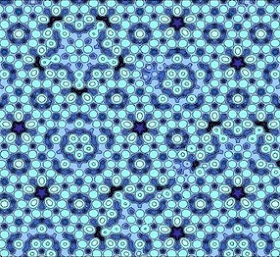Bizarre Crystal Hitched Ride on Meteorite | Chondrites & Meteorite Collisions | Space Rocks & Early Solar System | LiveScience
A rock sample containing quasicrystals unearthed in the Koryak Mountains in Russia.CREDIT: Paul Steinhardt, Princeton University
A rock fragment containing a previously unidentified natural quasicrystal may be the remnant of a meteorite that originated in the early solar system more than 4.5 billion years ago before Earth even existed.
Until now, researchers had assumed such quasicrystals, whose atoms are arranged in a quasi-regular pattern rather than the regular arrangement of atoms inside a crystal, were not feasible in nature. In fact, until now the only known quasicrystals were synthetic, formed in a laboratory under carefully controlled conditions. (This year's Nobel Prize in chemistry honored Dan Shechtman for his 1982 discovery of quasicrystals, which at the time were thought to break the laws of nature.)
The quasicrystal from outer space : Nature News & Comment
The only known natural example of the material that won last year's Nobel Prize in Chemistry comes from an ancient meteorite.Alien origins
In the latest study, Bindi joined with Steinhardt and other US scientists to analyse the rock. The ratios of isotopes of oxygen in silicate and oxide minerals around the quasicrystal grain are typical of minerals found in meteorites called carbonaceous chondrites, the team reports1. This indicates that the rock is of extraterrestrial origin and very old: virtually all chondrites formed at the birth of the Solar System. It is likely, but not certain, that the quasicrystal grain within the meteorite is of roughly the same age. It was found entwined with a silica mineral that forms only at high pressures and temperatures — such as might be created by a collision with the chondrite body.
What are Quasicrystals, and What Makes Them Nobel-Worthy? | The Rundown News Blog | PBS NewsHour | PBS
The 2011 Nobel Prize in chemistry was awarded on Wednesday to an Israeli scientist named Dan Shechtman who discovered a type of crystal so strange and unusual that it upset the prevailing views on the atomic structure of matter, leading to a paradigm shift in chemistry.
But why? What's so special about quasicrystals?
[...]
Pat Theil, a senior scientist at the U.S. Energy Department's Ames Laboratory and a professor of materials science at Iowa State University, uses the analogy of tiling a bathroom floor. Only tiles of certain shapes fit together snugly without creating unsightly holes.
"If you want to cover your bathroom floor, your tiles can be rectangles or triangles or squares or hexagons," Thiel said. "Any other simple shape won't work, because it will leave a gap. In a quasicrystal, imagine atoms are at the points of the objects you're using. What Danny discovered is that pentagonal symmetry works."
Introduction to Quasicrystals
1. What Are Quasicrystals ? 2. The Concept of Higher Dimensional Space 3. What Do We Need Tilings For ? 4. Types of Quasicrystals 5. Diffraction pattern symmetries 6. Systems with Quasicrystals 7. Experimental Techniques 8. Structure Solution Techniques 9. Morphology 10. IMS versus QC
Source: Introduction to Quasicrystals
Related


